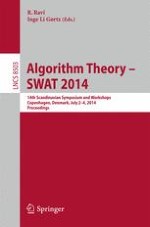This book constitutes the refereed proceedings of the 14th International Scandinavian Symposium and Workshops on Algorithm Theory, SWAT 2014, held in Copenhagen, Denmark, in July 2014. The 33 papers were carefully reviewed and selected from a total of 134 submissions. The papers present original research and cover a wide range of topics in the field of design and analysis of algorithms and data structures including but not limited to approximation algorithms, parameterized algorithms, computational biology, computational geometry and topology, distributed algorithms, external-memory algorithms, exponential algorithms, graph algorithms, online algorithms, optimization algorithms, randomized algorithms, streaming algorithms, string algorithms, sublinear algorithms and algorithmic game theory.
